No way, I figured when I saw what was happening before me. Two male Common Mergansers were fighting over what appeared to be a way-too-large fish. By the time I was able to get into position to photograph, one of the males took possession of the big fish, but after trying to swallow the oversized fish, it dropped the monster and the other merganser quickly swam forward to pick up the fish and try to swallow it too. The back and forth among the mergansers continued 4 times across the frigid open water, with the animated chase providing an interesting series of photos.
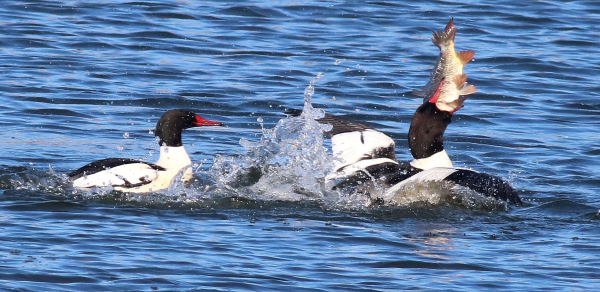
As I followed the action through my telephoto lens, it was hard to imagine that either of the mergansers would actually be able to swallow such a big fish, which clearly appeared to be way too large to fit inside a Common Merganser’s mouth, much less down its throat – no way! Even so, the competition between the male mergansers was spirited and sometimes quite physical with flapping and pushing to take possession of the fish – probably a carp.
Promptly, the most aggressive male positioned the fish in front of it, then picked it up in its mouth – head first. I was surprised to see how the merganser could raise the fish high in the air, time and time again, apparently trying to use gravity to help pressure the fish down its throat, while keeping the fish away from the other male. And that’s when the action became more dramatic and provided the best opportunities to photograph the birds with the fish.
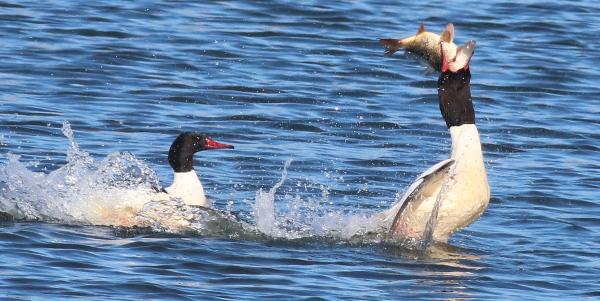
Tech Talk
I positioned myself on the south shore of the lake, where I had the best afternoon sunlight including both the light’s direction and angle. As for camera tech settings, I used a wider than usual f10 aperture to try to keep both birds and the fish within the area of focus. Using my favored aperture priority (Av) mode setting, the camera automatically set a corresponding 1/1000 shutter speed, which did a good job of keeping the action sharp, including the spraying water. There were a couple physical considerations too, in that I tried as best I could to stabilize my camera and lens from a standing position. I accomplished this by forming a bi-pod, holding my elbows tight against my chest – and by holding my breath each time I took a photo.
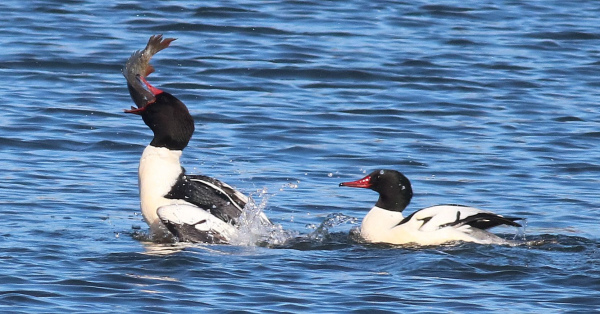
Back to the Action
Four different times, one or the other merganser grabbed the fish in its mouth and tried heartily to get the oversized fish past the widest point of its bill gape, and 3 times the fish was dropped and the process was attempted again. There was a level of hunger or winter survival involved in the action; the birds obviously seemed to need the food. Plus there was a lot of competition between the 2 mergansers, possibly also fueled by the need to eat that winter day. The resulting action was fast-paced, and it was sure fun to photograph!
After the third attempt by one of the mergansers to swallow the fish, once again I thought, no way! But as Wayne and Garth would say, “Way!” And although the fourth attempt at swallowing the too big fish seemed as unswallowable as ever, persistence finally paid off and the fish, miraculously, was swallowed! The merganser raised up to flap victoriously, although it was probably as much to help position the fish in its stomach.
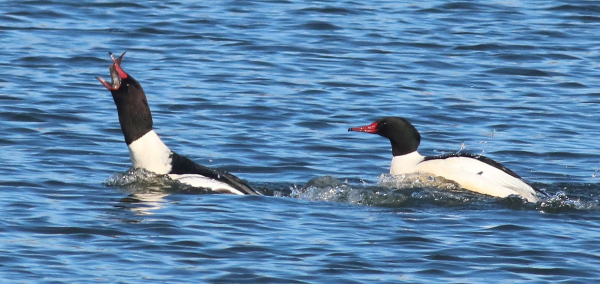
Merganser Notes
Time and time again I have hoped and tried to get close enough to get some pleasing photos of wintering Common Mergansers, but they were always just a little too far away to get good detailed images. This is essentially true for almost all interactions with this species of specialized ducks. Unlike most other ducks, mergansers primarily eat fish, and lacking the large flat bills of most ducks, their thin bills lined with serrated tooth-like edges allow them to more easily catch and hold fish – usually small fish. Fish are caught underwater with the mergansers swimming quickly in pursuit of fish, usually minnow-sized.
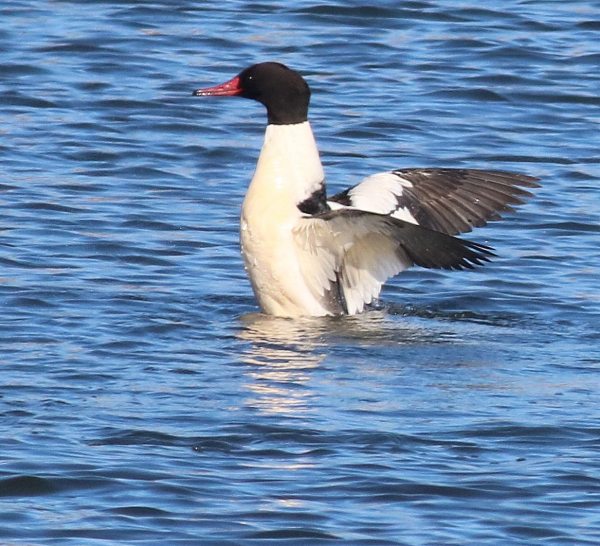
Taking and sharing a series of photos can be especially fulfilling.
|
Many people wouldn’t initially identify a merganser as a duck, and the species probably has many qualities that would lead beginners to imagine they were looking at a loon or large grebe-like waterbird – and in some ways they resemble loons or large grebes – but all mergansers are indeed specialized ducks.
Important aspects of bird photography include documenting birds, bird behavior, and taking action photographs – all of which are included in this article. A documentary series of photos is always compelling, and offers detailed looks at how the action takes place. Cameras are important birding tools, and they can be our most important birding equipment of all. And you never know when an interesting activity will transpire before you – or a rare bird will suddenly appear for you to document. Good luck!
Article and photographs by Paul Konrad
Share your bird photos and birding experiences at editorstbw2@gmail.com